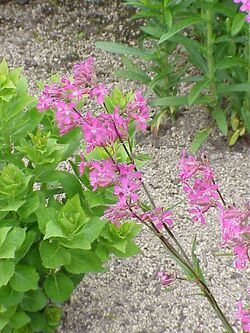Biology:Viscaria vulgaris
| Viscaria vulgaris | |
|---|---|

| |
| Scientific classification | |
| Kingdom: | Plantae |
| Clade: | Tracheophytes |
| Clade: | Angiosperms |
| Clade: | Eudicots |
| Order: | Caryophyllales |
| Family: | Caryophyllaceae |
| Genus: | Viscaria |
| Species: | V. vulgaris
|
| Binomial name | |
| Viscaria vulgaris Röhl.[1]
| |
| Synonyms[2] | |
|
List
| |
Viscaria vulgaris, the sticky catchfly[3] or clammy campion,[4] is a flowering plant in the family Caryophyllaceae.
It is an upright perennial growing to 60 cm (24 in) in height. The leaves are lanceolate. The flowers, which are 20 mm across and bright rosy-pink, appear in long whorled spikes from May to August. It grows on cliffs and rocky places.[5][6] In Central Europe, Lychnis viscaria can be found in a variety of habitats, such as dry meadows, lush grasslands, stony slopes, rocky outcrops of hilly terrain, and open or sparse canopied forests. It has taken over vineyards and roadside vegetation, and farming methods that preserve open vegetation are advantageous to it.[7]
The Latin name Viscaria means "sticky", and refers to the stickiness of the stem just below the leaf joints.[8] The English common names reference the same feature.
Viscaria vulgaris is also grown as an ornamental garden plant. In British horticultural literature it is often referred to by its synonym Lychnis viscaria. Bumblebees are considered as main pollinators of this species.[9] The cultivar 'Splendens Plena', a double-flowered form, has won the Royal Horticultural Society’s Award of Garden Merit. [10][11]
References
- ↑ Deutschl. Fl., ed. 2, 2: 275 (1812)
- ↑ "Viscaria vulgaris Röhl.". Board of Trustees of the Royal Botanic Gardens, Kew. 2017. https://powo.science.kew.org/taxon/urn:lsid:ipni.org:names:159789-1.
- ↑ "Online atlas of the British & Irish flora: Lychnis viscaria (Sticky catchfly)". Biological Records Centre and Botanical Society of Britain and Ireland. https://www.brc.ac.uk/plantatlas/index.php?q=plant/lychnis-viscaria.
- ↑ "Lychnis viscaria". Natural Resources Conservation Service PLANTS Database. USDA. https://plants.usda.gov/core/profile?symbol=LYVI2.
- ↑ New Flora of the British Isles; Clive Stace; Third edition; 2011 printing
- ↑ The Wild Flowers of Britain and Northern Europe; Fitter, Fitter, Blamey; Collins; 3rd edition 1978
- ↑ Wilson, G. B.; Wright, J.; Lusby, P.; Whittington, W. J.; Humphries, R. N. (1995). "Lychnis Viscaria L. (Viscaria Vulgaris Bernh.)". Journal of Ecology 83 (6): 1039–1051. doi:10.2307/2261185. ISSN 0022-0477. https://www.jstor.org/stable/2261185.
- ↑ Harrison, Lorraine (2012). RHS Latin for Gardeners. United Kingdom: Mitchell Beazley. ISBN 978-1845337315.
- ↑ Mustajärvi, Kaisa; Siikamäki, Pirkko; Rytkönen, Saara; Lammi, Antti (2001). "Consequences of plant population size and density for plant-pollinator interactions and plant performance: Plant-pollinator interactions" (in en). Journal of Ecology 89 (1): 80–87. doi:10.1046/j.1365-2745.2001.00521.x. https://onlinelibrary.wiley.com/doi/10.1046/j.1365-2745.2001.00521.x.
- ↑ "Lychnis viscaria 'Splendens Plena'". Royal Horticultural Society. https://www.rhs.org.uk/Plants/66352/Lychnis-viscaria-Splendens-Plena-(d)/Details.
- ↑ "AGM Plants - Ornamental". Royal Horticultural Society. July 2017. p. 61. https://www.rhs.org.uk/plants/pdfs/agm-lists/agm-ornamentals.pdf.
Wikidata ☰ {{{from}}} entry
 |





